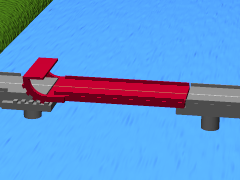Bascule bridge
This article needs additional citations for verification. (November 2009) |
This animation shows the movement of a double leaf bascule. | |
| Ancestor | Drawbridge, Plate girder bridge, cantilever bridge |
|---|---|
| Related | Lift bridge, swing bridge |
| Descendant | None |
| Carries | Pedestrian, automobile, truck, light rail, heavy rail |
| Span range | Short |
| Material | Steel |
| Movable | Yes |
| Design effort | Medium |
| Falsework required | Site and prefabrication specific |
A bascule bridge (sometimes referred to as a drawbridge) is a moveable bridge with a counterweight that continuously balances the span, or "leaf," throughout the entire upward swing in providing clearance for boat traffic. Bascule is a French term for seesaw and balance, and bascule bridges operate along the same principle. They are the most common type of movable bridge in existence because they open quickly and require relatively little energy to operate.
Bascule bridges may be single or double leaf. Double leaf bridges usually have any truss structure and counterweights below the deck, while a single leaf bridge is typically a truss bridge with an elevated counterweight.
History
Although the bascule bridge has been in use since ancient times, it was not until the 1850s that engineers developed the ability to move very long, heavy spans quickly enough for practical application. The Blagoveshchensky Bridge across the Neva River in Saint Petersburg was the first large bascule bridge, opened in 1850.[citation needed] Since then, all bridges across the Neva and other major rivers in the city (21 in total) were bascule to facilitate navigation, which prevented the city's inhabitants from traveling across the river at night (this remained so until 2003 when the first cable-stayed bridge across the Neva was opened).
Design

Counterweights may be located above the bridge or below the deck of the bridge. There are two common designs of bascule bridge. One is the fixed-trunnion bascule design, which is where the bridge rotates around a large axle called a trunnion to raise. This bridge type is sometimes called the 'Chicago bascule' as this type was developed and perfected there and is used for many of that city's river crossings. Joseph Strauss was a key person who worked on improving the trunnion bascule bridge. Another form of bascule bridge is the Scherzer rolling lift bridge, also known as a Rolling Bascule Bridge. The city of Joliet, Illinois has a number of this structure type. The Scherzer rolling lift bridge essentially rolls or rocks like a simple rocking chair on a track to raise.[1]
Types
- Scherzer rolling lift bascule bridge
- Rall bascule bridge, patented by Theodore Rall in 1901.[citation needed]
- Strauss bascule bridge, patented by Joseph Strauss.
- Chicago or fixed-trunnion bascule bridge.
Tower Bridge

Tower Bridge across the Thames in London, UK is a famous bascule bridge. Originally, Tower Bridge was a hydraulically operated bridge, using steam power from coal-burning boilers to pump river water into six hydraulic accumulators so that power was readily available when required. The water for the boilers was provided by a well. The hydraulic accumulators powered the bascule engines, which raised and lowered the bascules. Today, the bascule mechanism is driven by oil and electricity rather than by water and steam.[2]
Gallery
-
A double-leaf bascule bridge (Burnside Bridge, Portland, Oregon)
-
Rolling lift Pegasus Bridge
-
Single-leaf through truss with overhead counterweight, Seattle, Washington
-
The Ashtabula lift bridge, a Strauss bascule bridge built in 1925
-
A double-leaf bascule bridge fully open
-
The Johnson Street Bridge, a Strauss bascule bridge built across the Victoria Harbour, Victoria, British Columbia
in 1924 -
Bascule bridge in Montceau-les-Mines, France
-
A view from a Bridge command center on the Fremont Bridge in Seattle, Washington, where the Bridge Operator is controlling the bridge.
-
Wabash Avenue Bridge in an Undated photo from the National Park Service
See also
- Bridge
- Drawbridge
- Joseph Strauss
- List of bascule bridges
- Moveable bridge for a list of other movable bridge types.
- Pegasus Bridge for an example of a rolling bascule bridge, employing a rack and pinion rather than hinge pins.
References
- ^
Koglin, Terry L. (2003). "4. Bascule Bridges". Movable bridge engineering. John Wiley and Sons. ISBN 9780471419600. Retrieved May 25th 2009.
{{cite book}}: Check date values in:|accessdate=(help); Cite has empty unknown parameters:|laydate=and|laysummary=(help); External link in|chapterurl=|chapterurl=ignored (|chapter-url=suggested) (help); Unknown parameter|separator=ignored (help)CS1 maint: postscript (link) - ^ "Tower Bridge Exhibition". Retrieved May 25th 2009.
{{cite web}}: Check date values in:|accessdate=(help)









